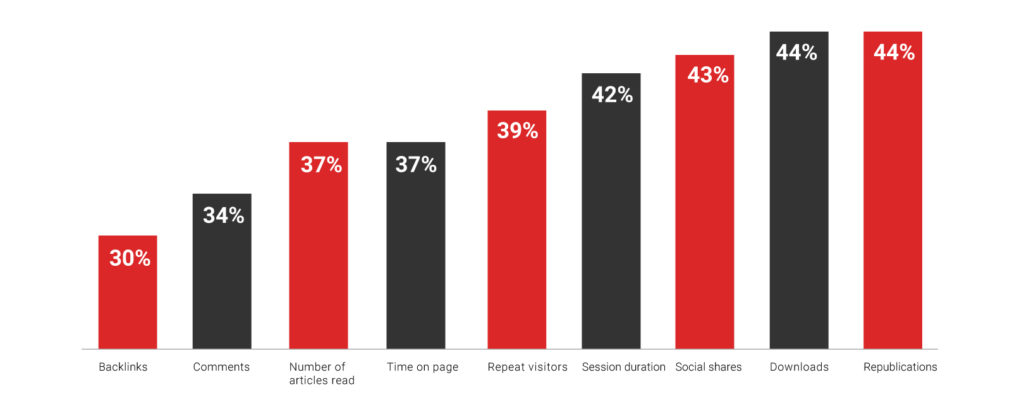B2B thought leadership marketing ranks in the top 5 content marketing goal priorities for 42% of B2B marketers, highlighting how quality content from subject matter experts can provide truly valuable insights for B2B buyers.
This is according to our first party research conducted among 200 senior B2B marketing professionals from our Insights for Professionals (IFP) community.
As more and more companies embrace thought leadership content marketing as a powerful way of winning the trust and attention of their target audiences, content teams are under increasing pressure to produce a steady stream of valuable leadership content that engages and educates their readers.
This article takes a deep dive into the psychology of thought leadership, along with some actionable tips for applying this knowledge to establish an authoritative brand voice.
How can B2B thought leadership marketing be achieved and how can B2B marketers use it to deliver more valuable content to wider audiences? Read on to discover more…
Reading time: 5 minutes

It’s vital to reach and engage target audiences at the top of the funnel to effectively compete for attention. Thought leadership content is well-suited for this level of engagement as it dials down the self-promotion and ramps up the unconscious signifiers for trust and authority. By understanding the science behind this approach content teams can develop leadership content strategies that deliver impressive ROIs.
Uncovering the unconscious social conditioning we all succumb to
Several factors come into play in shaping behavior, many of which we may not even be aware. Dr. Robert Cialdini’s 6 Principles of Persuasion neatly outlines these mechanisms of influence with 3 of them being directly applicable to B2B thought leadership marketing. These principles are:
The Principle of Authority
With the abundance of online content available, the buying process for time-poor B2B decision-makers has become lengthier and more complex. As a result, buyers look for short cuts to help them navigate their decision making. Identifying subject matter experts and leveraging their opinion to pre-filter information and validate options is a common, time saving technique. This is where Cialdini’s Third Principle of Persuasion comes into play. Thought leadership leverages this principle by positioning your brand as that helpful expert. By creating and disseminating quality content that resonates with your core audience, you can nurture long-term relationships that drive revenue straight into your business. If you want to achieve a significant impact, consider doing the following:
1. Build your expert positioning around a specific category or topic
One effective way to establish yourself as an authentic specialist is to demonstrate depth and insight to strengthen your expert positioning. Focusing on a specific category is an effective way of kicking off high-quality thought leadership content. It means your content will be focused and you can dedicate more resource to building a rich body of educational content that covers all the core pain points and challenges that exist within that topic area.
Aligning yourself with a specific category also has many Search Engine Optimization (SEO) benefits, as it allows you to publish keyword-rich content to help improve discoverability.
2. Provide unique, insightful content
According to our research 59% of respondents believe that research is crucial to the success of content marketing. Accurate and relevant research is at the heart of good B2B thought leadership marketing. Your audiences are coming to you to discover credible information through valuable content that will fast track their decision making. We can’t see into the future but with the right research we can better anticipate and forecast.
When planning your research, it’s helpful to use tools such as a PESTLE audit to gain a better understanding of the current industry landscape and identify prevailing trends that may influence your target audience’s buying decisions. This is key to generating research that provides relevant and actionable insights to inform your B2B thought leadership strategy.
It’s also important to consider the types of content that best fit your core audience at each stage of their buyer journey, to ensure that your research findings are presented in the most effective way possible. For instance, a comprehensive, gated white paper is a great way of driving brand awareness by educating the reader on a relevant topic while showcasing a compelling thought leadership piece.
The Principle of Consensus
Also known as social proof or proof of the crowd, social validation is a powerful psychological phenomenon that we all seek, often on a subconscious level. And this principle becomes even more important when we are uncertain about what to do or how to behave. In such instances, we look to the crowd for guidance and reassurance – for in numbers, comes safety. By Incorporating this mechanism into your thought leadership strategy you build a stronger influence among your audience. For example, would you trust a self-appointed expert with a following of 20 over an expert with an established audience of over a million? Perhaps not. While building a strong social media presence doesn’t happen overnight, there are a couple of marketing hacks you can use:
1. Owned channel tactic
Identify who the key influencers are in your field of expertise and build strategic partnerships. This may take the shape of contributor articles on your owned channels or co-sponsorship of a prime asset such as a research report. Having your brand associated with an influencer that holds greater kudos within your target community can significantly amp up your own credibility and authoritative brand voice. This content tactic also provides the opportunity to leverage link-building to improve SEO.
2. Third party channel tactic
44% of our survey participants say third party publishers are an effective channel. This can be particularly effective with B2B thought leadership marketing. Publishing your content where there is an established audience that meets your target audience criteria, allows you to increase your reach to larger audiences, while strengthening your authority.
Extending out your channel tactics also provides great opportunities to intercept and infiltrate your audiences’ digital eco system. This is crucial if you’re aiming to achieve multi touchpoint engagements.
The Principle of Reciprocity
Reciprocity is the principle of feeling obliged to return a favor. In content marketing, reciprocity plays a crucial role. Thought leadership marketing in the B2B industry leverages this principle by providing valuable content in exchange for audience trust and establishing marketplace authority. To enhance this value exchange, marketing teams can deploy the following tactics:
1. Carefully consider when to gate leadership marketing content
Starting at the top of the funnel, thought leadership aims to establish long-term relationships with target buyers, therefore, it’s important not to ask too much too soon. Content such as infographics, blog posts and thought leadership articles should be effortlessly accessible and expect little in return especially if you have not yet established yourself as a thought leader in your buyer’s minds..
Remember, it’s the value of your content that drives the incentive to return to your brand, time and time again, which is why creating compelling thought leadership pieces is essential.
2. Take an insight led approach to maximize perceived value
Relevancy breeds value. The more insights you can gather on your buyer, and act upon, the more effectively you can sustain the value exchange that leads to a purchase. By leveraging intent data you can continuously refine your leadership content strategy and ensure your content is meeting the specific information needs of your buyers.
Which metrics should be used to track strategic thought leadership performance?
The most popular metrics recognized by our B2B marketing survey panel as an indication of trust, authority and an industry leader are as follows:

While these metrics provide a useful insight into how your peers are measuring success, it’s crucial you align them with the content marketing goals and channel activity in your overarching leadership marketing plan.
Quality content for thought leadership success
Establishing credibility and trustworthiness is a key factor in developing long term engagements with your target audience. While we have explored some psychological hacks that can help fast track your B2B thought leadership marketing success, the fundamentals remain the same – produce helpful content that reaches the right buyers at the right times via the right channel tactics.
For further guidance on designing and implementing a successful thought leadership content strategy that delivers a strong ROI, why not download our full report: Dissecting the B2B Content Marketing Strategy.








